The Natural Soap Chef
The Natural Soap Chef
Making Luxurious Delights from
Cucumber Melon and Almond Cookie
to Chai Tea and Espresso Forte
HEIDI CORLEY BARTO
 Ulysses Press
Ulysses Press
Copyright text 2012 Heidi Corley Barto. Copyright photos 2012 Heidi Corley Barto except as noted below. Copyright concept and design 2012 Ulysses Press and its licensors. All Rights Reserved. Any unauthorized duplication in whole or in part or dissemination of this edition by any means (including but not limited to photocopying, electronic bulletin boards, and the Internet) will be prosecuted to the fullest extent of the law.
Published by:
Ulysses Press
P.O. Box 3440
Berkeley, CA 94703
www.ulyssespress.com
ISBN: 978-1-61243-088-1
Library of Congress Catalog Number 2012935761
10 9 8 7 6 5 4 3 2 1
Acquisitions editor: Keith Riegert
Managing editor: Claire Chun
Editor: Phyllis Elving
Proofreader: Lauren Harrison
Interior photographs: Heidi Corley Barto except stick blender Melica
Cover photographs: Heidi Corley Barto
Cover design: what!design @ whatweb.com
Distributed by Publishers Group West
IMPORTANT NOTE TO THE READER: Please be sure to read the following important note before using any of the information in this book! This book is a general introduction to the subject of making soap using lye, and the reader is strongly cautioned to take note of the following warnings before attempting to use or relying on any of the information in this book. The process of making soap using lye involves a degree of risk. It is the readers responsibility to ensure that he or she understands all such risks and possesses all necessary skills. It is also the readers responsibility to ensure that all proper storage, operation, regulatory, and safety rules are followed. It is also the readers responsibility to obtain any and all necessary permits, and to follow all local laws and building regulations. Any decision to use the information in this book must be made by the reader on his or her own good judgment. This book is sold without warranties or guarantees of any kind, and the author and publisher disclaim any responsibility or liability for personal injury, property damage, or any other loss or damage, however caused, relating to the information in this book.
This book is independently authored and published and no sponsorship or endorsement of this book by, and no affiliation with, any trademarked brands or other products mentioned or pictured within is claimed or suggested. All trademarks that appear in ingredient lists, photographs, and elsewhere in this book belong to their respective owners and are used here for informational purposes only. The authors and publishers encourage readers to patronize the quality brands other products mentioned and pictured in this book.
To my husband Rick
youre the cool whip to my cocoa!
CONTENTS
ONE BAR AND I WAS HOOKED
I bought my first bar of handmade soap at a craft fair when my two girls were small. The woman at the craft fair told me she made it in her home, from oils, lye, milk, and plants she grew in her garden. I bought a bar because it smelled so delicious, and I thought it was fascinating that someone had actually made it. Then I used it and just fell in love. The bar seemed to last forever, and the lather was wonderful.
I needed to learn how to make soap! I ordered every book from my local library that mentioned soap making, and I looked online for whatever information I could find. I learned that there are different ways to make soap. One way is to melt and pour. You buy a soap base, melt it, add elements such as color, fragrance, and exfoliants, and then pour it into a mold. Another way is rebatching. You shred existing soap, mix it with a liquid, and use that as your soap base. Both these methods are terrific ways to produce a quickly usable bar of soap, but they werent what I wanted. I wanted to be able to make my own soap base and have total control over every ingredient.
I found what I was looking for with cold process soap makingthe method Great Grandma used to made soap. She created soap from its basic components: lye + oil = soap. Great Grandma could be stirring that soap for days waiting for the necessary chemical reaction, but thanks to modern inventions such as the electric stick blender and the digital scale, the process is much faster and easier today!
SAPONIFICATIONThe chemical reaction that occurs when sodium hydroxide (lye), an alkali, meets a fatty acid (oil). The alkali splits the oil into two parts: a fatty acid and glycerin. The sodium joins with the fatty acid to form a sodium salt. Sodium salt is what we call bar soap.
Then I made some soap... and other things happened
After all my research, with the limited amount of information Id been able to find, I attempted my first batch. I made some bars from lard and lye, with no fragrance, and thought I was pretty awesome. A couple of batches later, we were overrun with lardy-smelling bars of soap. Soap production ceased because we needed to use up the bars Id already made. My husband, Rick, trooper that he is, helped me deplete my inventory of foul-smelling soaps.
Life happened. The company that Rick had been with for 171/2 years closed. While Rick looked for work, I started a new job at the library where Id checked out my soap-making books. We focused on raising our girls. Rick got a terrific new job, and I moved on to all sorts of different crafty endeavors. When I wanted to use homemade soap, I bought it from other soap makers.
Then Paige, my younger daughter, started to experience skin issues. I bought soap bar after soap bar, trying to find one that would help her dry, itchy skin. Then I had an epiphany: I would research different vegetable oils to see what each kind offered as far as benefits to the skin, and Id make soap for Paige and my family. I asked my older daughter, Gillian, a chemistry student at the time, if shed like to do an experiment in saponification with me. Sure, she agreed, having no clue what the heck I was talking about. Shed been just a child when Id last made soap.
We set out on our soaping adventure, leaving the lard alone and trying all sorts of vegetable oils instead. This time around, the resources were fantastic. There is so much support for soap makers, be it online or in print. I developed my own recipes and tailored them to my needs and the needs of my family. There were online soap calculators where I could plug in the types of oils I wanted to use and how much soap I wanted to make and learn what characteristics my soap would have. These tools helped me design a nice, hard bar that has great lather and is super moisturizing. Friends and family had fun testing my soap, and theyve given me all sorts of ideas for new recipes to create.
Real soap
Many people like to limit the chemicals they use, and cold process soap making is an excellent way to do that. The soap that you buy in the grocery store usually isnt true soap. Its detergent, consisting primarily of synthetic ingredients. In addition, manufacturers usually strip their soap products of glycerin (a natural by-product of cold process soap making) to use in other products. Glycerin is a humectant, meaning that it attracts moisture. Cold process soap made at home still contains all of its natural glycerin. Youll notice a difference in how it moisturizes your skin.
Next page

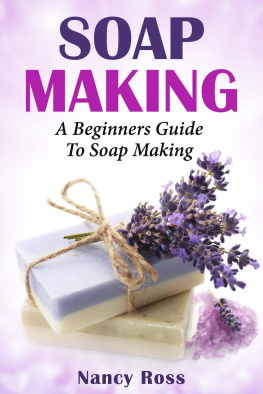

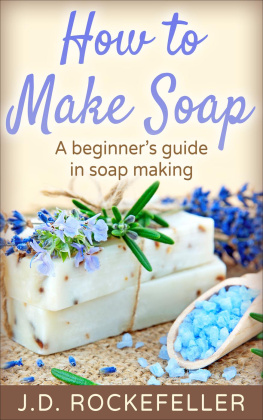
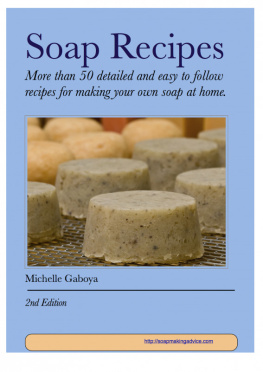
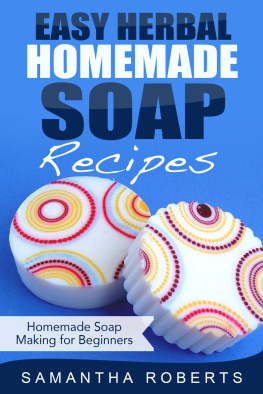
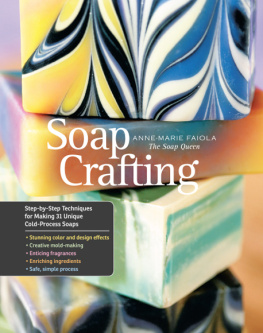
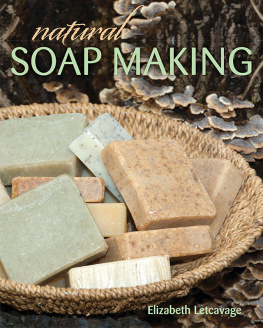
 Ulysses Press
Ulysses Press